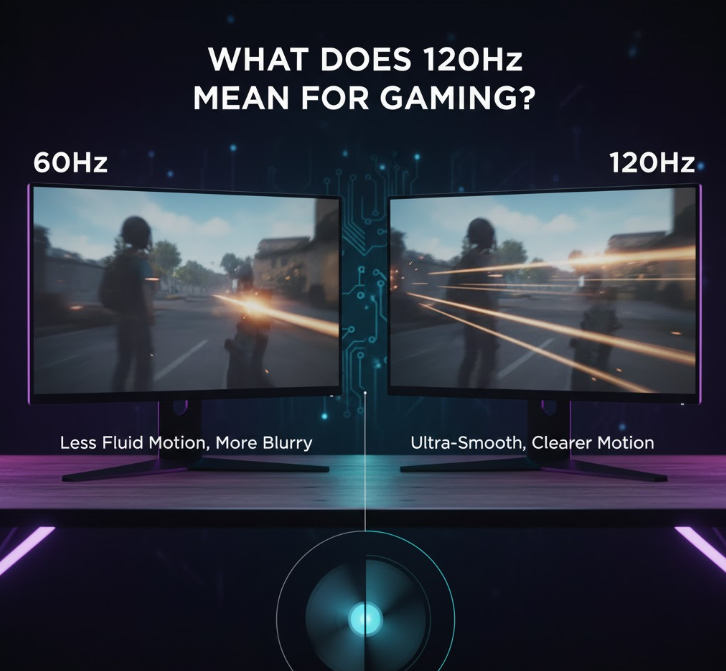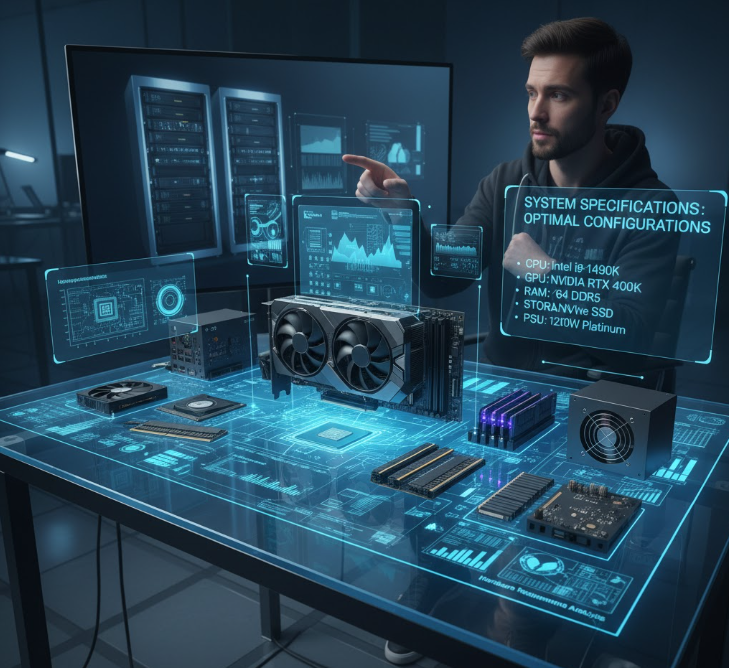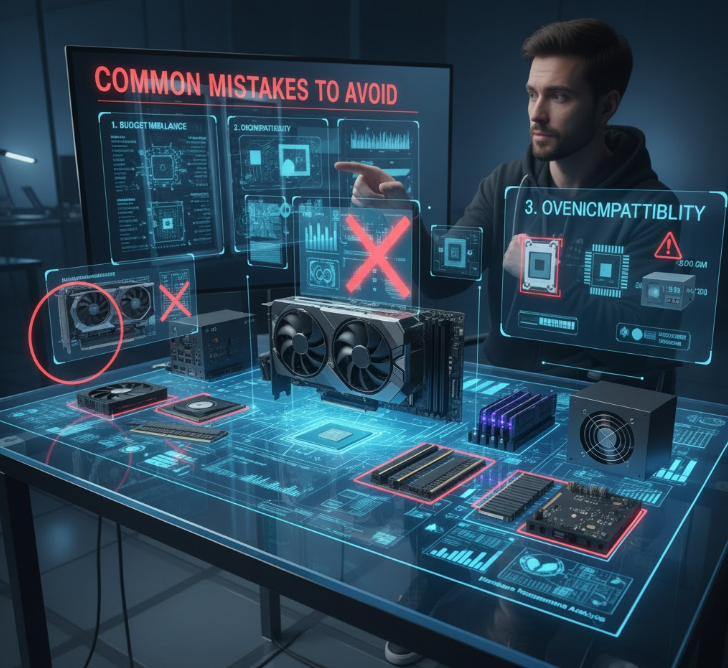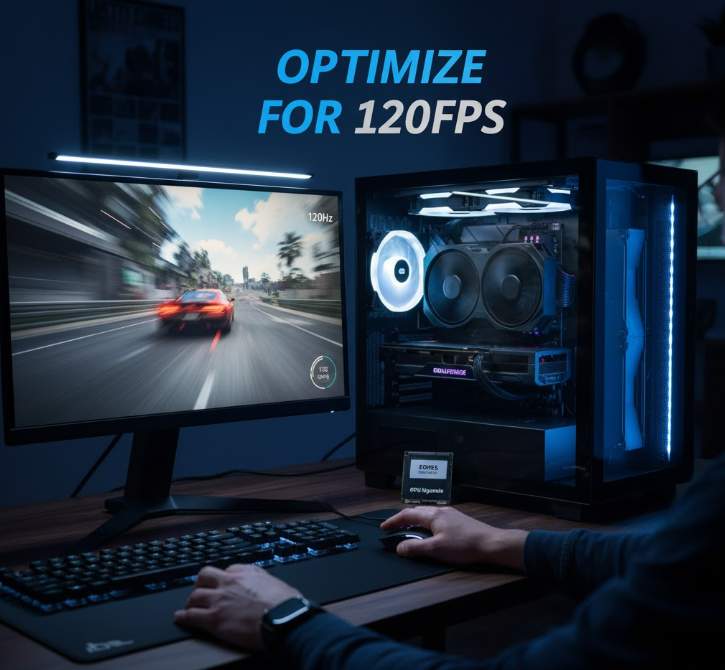If you want to experience ultra-smooth gameplay, optimizing your gaming PC for 120Hz is essential. The key is to ensure your system consistently delivers 120 frames per second (FPS) to match your monitor’s refresh rate, though there are several other factors you should consider before diving in. In my experience as a tech journalist who’s tested countless gaming setups over the years, a few targeted tweaks can make a dramatic difference in your gaming experience, but the journey to perfect 120Hz performance requires attention to both hardware and software.
Below, I’ll guide you through everything you need to know to get the most out of your 120Hz setup, from hardware upgrades to software settings, plus practical tips and step-by-step instructions. Let’s get started!
What Does 120Hz Mean for Gaming?

The difference between 60Hz and 120Hz is night and day. When I first tested a 120Hz monitor years ago, I was skeptical about whether I’d notice the improvement. Within minutes of gameplay, I couldn’t imagine going back. The smoothness of camera pans, the clarity during fast movements, and the reduced motion blur all contribute to a superior gaming experience.
A 120Hz monitor refreshes the image 120 times per second, allowing for smoother motion and reduced input lag compared to standard 60Hz displays. To fully benefit, your PC must output at least 120 FPS in your games. Otherwise, you won’t see the full effect, and you might experience screen tearing or stuttering.
Before we dive into hardware requirements, there’s one technology you absolutely need to know about: adaptive sync. Technologies like NVIDIA G-Sync and AMD FreeSync synchronize your monitor’s refresh rate with your GPU’s frame output, eliminating screen tearing and reducing stuttering even when your FPS drops below 120.
Here’s why this matters: you won’t always maintain a perfect 120 FPS in every game. When your frame rate fluctuates between 90-120 FPS, adaptive sync keeps everything smooth. Without it, you’ll experience visible tearing and judder. Make sure your monitor supports G-Sync (for NVIDIA GPUs) or FreeSync (for AMD GPUs, though many also work with NVIDIA cards). Enable it in your monitor’s settings and your GPU control panel.
Understanding the Hardware Requirements

Before we dive into optimization, it’s important to understand what hardware you need. Your monitor is just one piece of the puzzle. Your entire system needs to work in harmony to deliver consistent 120 FPS performance.
Your graphics card is the most critical component. It needs to render frames fast enough to keep up with your monitor’s refresh rate. Your CPU processes game logic and physics calculations, and if it’s too slow, it can bottleneck your GPU. Your RAM provides the working memory for your system, and insufficient RAM can cause stuttering. Finally, your storage drive affects loading times and can impact performance in games with streaming textures.
Quick Answer: How to Optimize for 120Hz
To optimize your gaming PC for 120Hz, you need to:
- Enable G-Sync or FreeSync in both your monitor settings and GPU control panel
- Cap your frame rate at 117-118 FPS (if using adaptive sync) to stay within the sync range
- Use a monitor that supports 120Hz or higher
- Ensure your graphics card and CPU can deliver 120 FPS in your games
- Set your Windows and in-game settings to 120Hz
- Update drivers and tweak performance settings
But there’s more to it—let’s break down each step so you can get the best results.
Step-by-Step Guide: Achieving 120Hz Gaming
Step 1: Verify Monitor Compatibility
First, confirm your monitor supports 120Hz or higher. Many monitors support multiple refresh rates, but you need to manually select the highest one. Go to your monitor’s specs or check in Windows:
Right-click on your desktop and select Display settings. Scroll down and click Advanced display settings. Under Refresh rate, select 120Hz if available.
If you don’t see 120Hz as an option, there could be several reasons. Your cable might not support the bandwidth required, your GPU might not support 120Hz at your current resolution, or your monitor might need to have 120Hz mode enabled in its on-screen display menu first.
Step 2: Choose the Right Cable
This is where many people go wrong. Not all cables are created equal. HDMI 1.4 can only support 120Hz at 1080p, and even then, it’s limited. For 1440p at 120Hz, you need HDMI 2.0 or higher. For 4K at 120Hz, you need HDMI 2.1 or DisplayPort 1.4.
DisplayPort is generally the better choice for high refresh rate gaming. It offers more bandwidth and better compatibility with gaming features like G-Sync and FreeSync. While testing various setups, I’ve found that DisplayPort consistently delivers the most reliable high refresh rate experience.
Step 3: Upgrade Your Graphics Card (If Needed)
A powerful GPU is essential for high-FPS gaming. For 120Hz at 1080p, mid-range cards like the NVIDIA RTX 3060 or AMD RX 6600 XT can handle most games at medium to high settings. For 1440p gaming, you’ll want an RTX 4070 or RX 7800 XT. For 4K at 120Hz, you’re looking at top-tier cards like the RTX 4080 or RX 7900 XTX.
Keep in mind that different games have vastly different performance requirements. Esports titles like Valorant, CS2, and League of Legends are easy to run at 120 FPS even on older hardware. But modern AAA titles like Cyberpunk 2077 or Starfield require serious GPU power to maintain 120 FPS, even at 1080p.
Step 4: Optimize Your CPU and RAM
Your CPU needs to keep up with your GPU. For 120 FPS gaming, you want a processor with strong single-thread performance. Games don’t always scale well across multiple cores, so clock speed matters more than core count for many titles.
Aim for at least a modern quad-core processor, but six cores is better. Intel’s 12th gen or newer, or AMD’s Ryzen 5000 series or newer, are solid choices. For RAM, 16GB is the minimum for modern gaming, but 32GB gives you more headroom for multitasking and future-proofing.
Make sure your RAM is running at its rated speed. Many systems default to slower speeds, and you need to enable XMP (Intel) or DOCP (AMD) in your BIOS to get the performance you paid for. In my experience, properly configured RAM can boost FPS by 10-15 percent in CPU-bound scenarios.
Step 5: Configure Windows Settings
Go to Display settings and then Advanced display settings. Select your monitor and set the refresh rate to 120Hz. Also, make sure Windows Game Mode is enabled. You can find this in Settings under Gaming. Game Mode optimizes your system resources for gaming by reducing background tasks.
Additionally, set your power plan to High Performance in Windows power settings. This prevents your CPU from downclocking during gaming sessions and ensures maximum performance.
Step 6: Tweak In-Game Settings
Every game is different, but there are general principles that apply. Start by setting your frame rate cap to unlimited or at least 120 FPS. Many games default to 60 FPS caps, which will prevent you from utilizing your 120Hz monitor.
Adjust graphics settings to find the right balance between visual quality and performance. Shadows are often performance killers, so dropping shadow quality from Ultra to High or Medium can give you significant FPS gains with minimal visual impact. Anti-aliasing is another heavy hitter. TAA and MSAA are demanding, while FXAA offers a lighter performance footprint.
Disable or reduce motion blur, depth of field, and ambient occlusion if you’re struggling to hit 120 FPS. These effects look nice in screenshots but are less noticeable during actual gameplay.
Enable V-Sync or adaptive sync in-game settings if your frame rate is unstable. However, if you have G-Sync or FreeSync enabled at the system level, you typically want to disable V-Sync in games to avoid input lag. The exception is enabling V-Sync with G-Sync if your frame rate exceeds your monitor’s maximum refresh rate, which prevents tearing above the sync range.
Frame time consistency is just as important as average FPS. A locked 100 FPS with consistent frame times will feel smoother than 120 FPS with wild fluctuations. Use in-game frame rate limiters or NVIDIA/AMD control panel settings to cap your frame rate at 117-118 FPS if you’re consistently exceeding 120 FPS—this keeps you in the adaptive sync range and provides the smoothest experience.
Step 7: Update Drivers and Software
Keeping your drivers updated is crucial. NVIDIA and AMD regularly release game-optimized drivers that can boost performance in specific titles. Use GeForce Experience for NVIDIA cards or AMD Adrenalin for AMD cards to keep your drivers current.
Also, update your motherboard chipset drivers and Windows itself. Game developers often release patches that improve optimization, so keep your games updated as well.
Step 8: Manage Background Applications
Background apps can steal precious system resources. Before gaming, close web browsers with multiple tabs, streaming software, RGB control software, and any other non-essential applications. Use Task Manager to identify resource hogs and disable unnecessary startup programs.
Table: Minimum Hardware Requirements for 120Hz Gaming
| Component | 1080p Gaming | 1440p Gaming | 4K Gaming |
|---|---|---|---|
| GPU | RTX 3060 / RX 6600 XT | RTX 4070 / RX 7800 XT | RTX 4080 / RX 7900 XTX |
| CPU | Intel i5 / Ryzen 5 | Intel i7 / Ryzen 7 | Intel i9 / Ryzen 9 |
| RAM | 16GB DDR4/DDR5 | 16GB DDR4/DDR5 | 32GB DDR4/DDR5 |
| Storage | SSD (500GB+) | SSD (1TB+) | SSD (2TB+) |
| Monitor | 120Hz+ | 120Hz+ | 120Hz+ |
Based on my professional experience, these specs will deliver a solid 120Hz experience in most modern games. For esports titles, you can get away with less, but for AAA games, aim higher.
Common Mistakes to Avoid

- Using the wrong cable: HDMI 1.4 won’t support 120Hz at high resolutions. Use DisplayPort or HDMI 2.0/2.1.
- Not setting refresh rate in Windows: Many users forget to change this, leaving their monitor at 60Hz.
- Ignoring driver updates: Outdated drivers can cause stuttering and lower FPS.
- Background apps hogging resources: Close unnecessary programs before gaming.
Step-by-Step: Setting Up 120Hz in Windows
- Connect your monitor using DisplayPort or HDMI 2.0/2.1
- Right-click on the desktop, select Display settings
- Scroll down and click Advanced display settings
- Select your monitor and set the refresh rate to 120Hz
- Apply changes and restart your PC if needed
While testing, I found that some monitors require you to manually set the refresh rate in their on-screen menu as well. Double-check your monitor’s settings if Windows doesn’t show 120Hz.
Pro Tips for Smoother 120Hz Gaming
- Enable G-Sync or FreeSync in both your monitor settings and GPU control panel
- Overclock your GPU (carefully) for extra FPS
- Keep your system cool—thermal throttling can lower performance
- Use game mode in Windows to prioritize gaming performance
- Disable unnecessary startup programs
- Keep your drivers up to date
Based on my experience, these tweaks can help you squeeze out every last frame for buttery-smooth gameplay.
Conclusion: Is 120Hz Gaming Worth the Effort?
Optimizing your gaming PC for 120Hz is absolutely worth it if you crave smooth, responsive gameplay. The process involves a mix of hardware upgrades, software tweaks, and regular maintenance. In my opinion, the jump from 60Hz to 120Hz is one of the most noticeable upgrades you can make for gaming. Just remember to check your monitor, use the right cables, and keep your system updated. With these steps, you’ll be ready to enjoy the full power of 120Hz gaming.
If you have a specific game or hardware setup in mind, let me know and I can tailor these tips even further!

